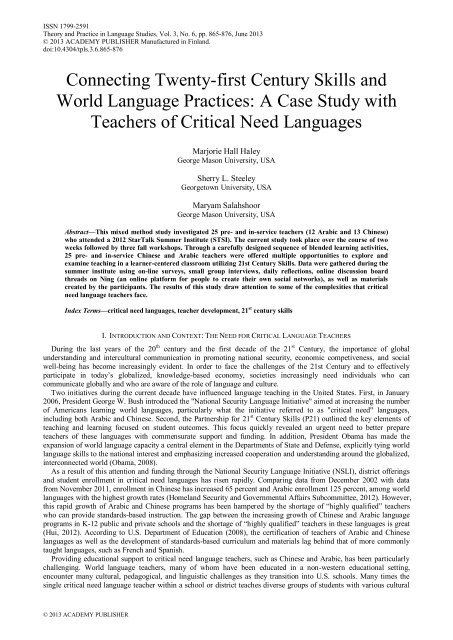Theory and Practice in Language Studies Contents - Academy ...
Theory and Practice in Language Studies Contents - Academy ...
Theory and Practice in Language Studies Contents - Academy ...
You also want an ePaper? Increase the reach of your titles
YUMPU automatically turns print PDFs into web optimized ePapers that Google loves.
ISSN 1799-2591<strong>Theory</strong> <strong>and</strong> <strong>Practice</strong> <strong>in</strong> <strong>Language</strong> <strong>Studies</strong>, Vol. 3, No. 6, pp. 865-876, June 2013© 2013 ACADEMY PUBLISHER Manufactured <strong>in</strong> F<strong>in</strong>l<strong>and</strong>.doi:10.4304/tpls.3.6.865-876Connect<strong>in</strong>g Twenty-first Century Skills <strong>and</strong>World <strong>Language</strong> <strong>Practice</strong>s: A Case Study withTeachers of Critical Need <strong>Language</strong>sMarjorie Hall HaleyGeorge Mason University, USASherry L. SteeleyGeorgetown University, USAMaryam SalahshoorGeorge Mason University, USAAbstract—This mixed method study <strong>in</strong>vestigated 25 pre- <strong>and</strong> <strong>in</strong>-service teachers (12 Arabic <strong>and</strong> 13 Ch<strong>in</strong>ese)who attended a 2012 StarTalk Summer Institute (STSI). The current study took place over the course of twoweeks followed by three fall workshops. Through a carefully designed sequence of blended learn<strong>in</strong>g activities,25 pre- <strong>and</strong> <strong>in</strong>-service Ch<strong>in</strong>ese <strong>and</strong> Arabic teachers were offered multiple opportunities to explore <strong>and</strong>exam<strong>in</strong>e teach<strong>in</strong>g <strong>in</strong> a learner-centered classroom utiliz<strong>in</strong>g 21st Century Skills. Data were gathered dur<strong>in</strong>g thesummer <strong>in</strong>stitute us<strong>in</strong>g on-l<strong>in</strong>e surveys, small group <strong>in</strong>terviews, daily reflections, onl<strong>in</strong>e discussion boardthreads on N<strong>in</strong>g (an onl<strong>in</strong>e platform for people to create their own social networks), as well as materialscreated by the participants. The results of this study draw attention to some of the complexities that criticalneed language teachers face.Index Terms—critical need languages, teacher development, 21 st century skillsI. INTRODUCTION AND CONTEXT: THE NEED FOR CRITICAL LANGUAGE TEACHERSDur<strong>in</strong>g the last years of the 20 th century <strong>and</strong> the first decade of the 21 st Century, the importance of globalunderst<strong>and</strong><strong>in</strong>g <strong>and</strong> <strong>in</strong>tercultural communication <strong>in</strong> promot<strong>in</strong>g national security, economic competiveness, <strong>and</strong> socialwell-be<strong>in</strong>g has become <strong>in</strong>creas<strong>in</strong>gly evident. In order to face the challenges of the 21st Century <strong>and</strong> to effectivelyparticipate <strong>in</strong> today’s globalized, knowledge-based economy, societies <strong>in</strong>creas<strong>in</strong>gly need <strong>in</strong>dividuals who cancommunicate globally <strong>and</strong> who are aware of the role of language <strong>and</strong> culture.Two <strong>in</strong>itiatives dur<strong>in</strong>g the current decade have <strong>in</strong>fluenced language teach<strong>in</strong>g <strong>in</strong> the United States. First, <strong>in</strong> January2006, President George W. Bush <strong>in</strong>troduced the "National Security <strong>Language</strong> Initiative" aimed at <strong>in</strong>creas<strong>in</strong>g the numberof Americans learn<strong>in</strong>g world languages, particularly what the <strong>in</strong>itiative referred to as "critical need" languages,<strong>in</strong>clud<strong>in</strong>g both Arabic <strong>and</strong> Ch<strong>in</strong>ese. Second, the Partnership for 21 st Century Skills (P21) outl<strong>in</strong>ed the key elements ofteach<strong>in</strong>g <strong>and</strong> learn<strong>in</strong>g focused on student outcomes. This focus quickly revealed an urgent need to better prepareteachers of these languages with commensurate support <strong>and</strong> fund<strong>in</strong>g. In addition, President Obama has made theexpansion of world language capacity a central element <strong>in</strong> the Departments of State <strong>and</strong> Defense, explicitly ty<strong>in</strong>g worldlanguage skills to the national <strong>in</strong>terest <strong>and</strong> emphasiz<strong>in</strong>g <strong>in</strong>creased cooperation <strong>and</strong> underst<strong>and</strong><strong>in</strong>g around the globalized,<strong>in</strong>terconnected world (Obama, 2008).As a result of this attention <strong>and</strong> fund<strong>in</strong>g through the National Security <strong>Language</strong> Initiative (NSLI), district offer<strong>in</strong>gs<strong>and</strong> student enrollment <strong>in</strong> critical need languages has risen rapidly. Compar<strong>in</strong>g data from December 2002 with datafrom November 2011, enrollment <strong>in</strong> Ch<strong>in</strong>ese has <strong>in</strong>creased 65 percent <strong>and</strong> Arabic enrollment 125 percent, among worldlanguages with the highest growth rates (Homel<strong>and</strong> Security <strong>and</strong> Governmental Affairs Subcommittee, 2012). However,this rapid growth of Arabic <strong>and</strong> Ch<strong>in</strong>ese programs has been hampered by the shortage of “highly qualified” teacherswho can provide st<strong>and</strong>ards-based <strong>in</strong>struction. The gap between the <strong>in</strong>creas<strong>in</strong>g growth of Ch<strong>in</strong>ese <strong>and</strong> Arabic languageprograms <strong>in</strong> K-12 public <strong>and</strong> private schools <strong>and</strong> the shortage of “highly qualified” teachers <strong>in</strong> these languages is great(Hui, 2012). Accord<strong>in</strong>g to U.S. Department of Education (2008), the certification of teachers of Arabic <strong>and</strong> Ch<strong>in</strong>eselanguages as well as the development of st<strong>and</strong>ards-based curriculum <strong>and</strong> materials lag beh<strong>in</strong>d that of more commonlytaught languages, such as French <strong>and</strong> Spanish.Provid<strong>in</strong>g educational support to critical need language teachers, such as Ch<strong>in</strong>ese <strong>and</strong> Arabic, has been particularlychalleng<strong>in</strong>g. World language teachers, many of whom have been educated <strong>in</strong> a non-western educational sett<strong>in</strong>g,encounter many cultural, pedagogical, <strong>and</strong> l<strong>in</strong>guistic challenges as they transition <strong>in</strong>to U.S. schools. Many times thes<strong>in</strong>gle critical need language teacher with<strong>in</strong> a school or district teaches diverse groups of students with various cultural© 2013 ACADEMY PUBLISHER
















